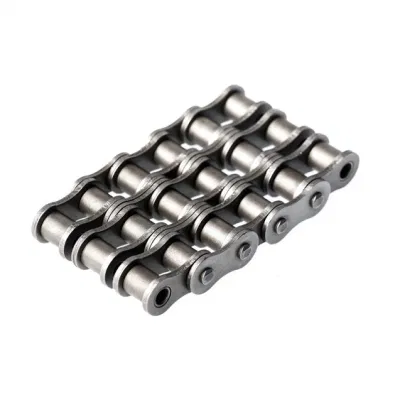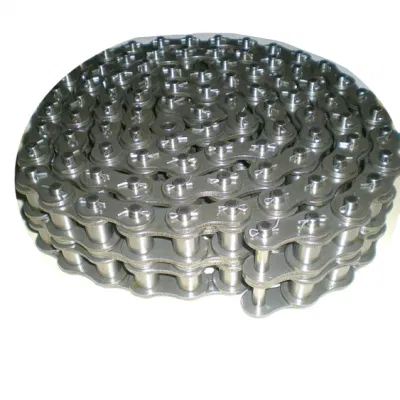Product Description
Precision Standard Timing Chains (Bush Chains)
Products are made of high quality alloy steel production. The plates are punched and squeezed bores by precision technology. The pin, bush, roller are machined by high-efficiency automatic equipment and automatic grinding equipment, then through heat treatment of carburization, carbon and nitrogen protection mesh belt furnace, surface blasting process etc. Assembled precision by Internal hole position, spin riveted by pressure to ensure the performance of the entire chain.
Specifications
| Technique Treatment | |||
| 1 | Shot Peening | 8 | Tempering |
| 2 | Bluing | 9 | Oiling |
| 3 | Nickel-plated | 10 | Greasing |
| 4 | Zincing | 11 | Special color |
| 5 | Heat Treatment | 12 | Stain proofing |
| 6 | Carburizing | 13 | Pre-stretched and anti-fatigue |
| 7 | Quenching | ||
Our Service
1. Any of your kind inquiry conveyor chain would be replied within 24 hours.
2. Well-trained and experienced sales staffs will reply all your concerns in fluent English.
3. OEM services are available with us, our professional designer would make your private idea into being.
4. Protection of your sales area, ideas of design and all your private information.
5. Delivery by air mail or ship for your orders.
Why choose us
1. We are the manufacture.
2. We have near 30 years experience of making chains and chain links.
3. Our design team has extensive experience in the chain design.
4. Best service and prompt delivery.
5. We offer various styles, size and colors to meet your requirement.
6. We covering a production area of 18750 square CHINAMFG have more than 100 employees and we have a complete set of testing equipment to ensure our quality.
| Surface Treatment: | Oxygenation |
|---|---|
| Structure: | Roller Chain |
| Material: | Alloy/Carbon Steel |
| Sample: | Available |
| Packages: | Can Be Customized |
| OEM: | Available |
| Samples: |
US$ 0/Piece
1 Piece(Min.Order) | |
|---|
| Customization: |
Available
| Customized Request |
|---|

Can a bush chain be used in food processing industries?
Yes, bush chains can be used in food processing industries, provided that they meet certain criteria to ensure food safety and hygiene. When selecting a bush chain for food processing applications, several factors should be considered:
1. Material compatibility: The chain material should be food-grade and suitable for contact with food products. Stainless steel, particularly austenitic stainless steel grades like 304 and 316, is commonly used due to its corrosion resistance, durability, and ease of cleaning. These materials are non-toxic and do not contaminate the food.
2. Lubrication: In food processing applications, it is important to consider the lubrication requirements. Some bush chains are available with self-lubricating properties or require food-grade lubricants that are safe for incidental contact with food. This ensures that the lubrication used does not pose a risk of contamination.
3. Cleanability: The bush chain should be designed in a way that allows for easy cleaning and maintenance. Smooth surfaces, without crevices or hard-to-reach areas, are preferred to prevent the accumulation of food particles, bacteria, or other contaminants. The chain should also withstand frequent cleaning processes, including washdowns with cleaning solutions or high-pressure water.
4. FDA and regulatory compliance: It is important to ensure that the bush chain and associated components comply with relevant food safety regulations, such as those set by the FDA (Food and Drug Administration) in the United States or similar regulatory bodies in other countries. Compliance with these regulations helps to maintain food safety standards.
5. Sanitary design: The bush chain should adhere to sanitary design principles, which include features such as smooth surfaces, no exposed threads, and easy disassembly for cleaning. This helps prevent the growth of bacteria and ensures the chain can be effectively sanitized.
By considering these factors and selecting a bush chain that meets the specific requirements of the food processing industry, it is possible to use bush chains safely and effectively in various applications, including conveying, sorting, packaging, and processing of food products.

What are the design considerations for a bush chain system?
When designing a bush chain system, several key considerations should be taken into account to ensure its reliable and efficient operation. These design considerations include:
1. Load capacity: Evaluate the expected loads that the bush chain system will need to handle. Consider the weight, size, and type of materials or products being conveyed or transmitted. Select a bush chain with a suitable load capacity to ensure it can withstand the required loads.
2. Speed and acceleration: Determine the desired operating speed and acceleration of the bush chain system. This will influence the selection of chain pitch, material, and lubrication requirements. Higher speeds may require additional considerations such as reduced friction or increased precision.
3. Environmental conditions: Evaluate the operating environment for the bush chain system. Consider factors such as temperature, humidity, dust, chemicals, and presence of corrosive or abrasive substances. Select a bush chain material and coating that can withstand the environmental conditions and resist corrosion or wear.
4. Space limitations: Assess the available space for the installation of the bush chain system. Consider the dimensions and layout of the equipment, conveyor, or transmission system. Ensure that there is sufficient clearance for the chain’s movement and that the system can be properly tensioned and aligned.
5. Alignment and tensioning: Proper tensioning and alignment are critical for the smooth operation of a bush chain system. Design the system to include tensioners, idler sprockets, or adjustable mounting options to facilitate easy tensioning and alignment adjustments.
6. Lubrication and maintenance: Determine the lubrication requirements of the bush chain system. Consider the frequency and method of lubrication, as well as any accessibility constraints for maintenance. Select a lubrication method that suits the application, such as manual lubrication, automatic lubrication systems, or self-lubricating bush chains.
7. Safety considerations: Ensure that the bush chain system is designed with appropriate safety measures. Incorporate guards, covers, or enclosures where necessary to prevent accidental contact with moving parts. Consider emergency stop systems and safety interlocks for the protection of personnel and equipment.
By carefully considering these design factors, a bush chain system can be optimized for performance, reliability, and longevity in a specific application or industry.

How does a bush chain differ from other types of chains?
A bush chain, also known as a bush roller chain or bushing chain, differs from other types of chains in its construction and design. Here are the key ways in which a bush chain differs:
1. Bushing Design: The main distinguishing feature of a bush chain is the presence of bushings or sleeves between the inner and outer links. These bushings serve as bearings that reduce friction and wear between the chain components, resulting in smoother operation and increased chain life.
2. Simplex, Duplex, and Triplex Configurations: Bush chains are available in different configurations, including simplex, duplex, and triplex. These configurations refer to the number of strands of chain running parallel to each other. This allows for increased load capacity and higher torque transmission in the chain system.
3. Link Plate Design: The link plates in a bush chain are typically thicker and heavier compared to other types of chains. This design provides enhanced strength and durability, allowing the chain to withstand heavy loads and resist elongation under tension.
4. Precision Bushing Fit: The bushings in a bush chain have a precise fit with the pins, which ensures proper alignment and smooth rotation. This reduces friction, minimizes wear, and improves the overall efficiency of the chain system.
5. Lubrication Requirements: Bush chains usually require regular lubrication to maintain optimal performance and reduce friction between the components. Lubrication helps prevent wear and corrosion, ensuring the longevity of the chain.
6. Wide Range of Applications: Bush chains are versatile and find applications in various industrial settings, including machinery, automotive systems, agriculture, material handling, mining, and more. Their robust construction and ability to handle high loads make them suitable for demanding applications.
Overall, the inclusion of bushings, the configuration options, and the design characteristics of bush chains distinguish them from other types of chains. Their unique features make them ideal for applications that require durability, high load capacity, and reduced friction for reliable power transmission.


editor by CX 2023-10-12
